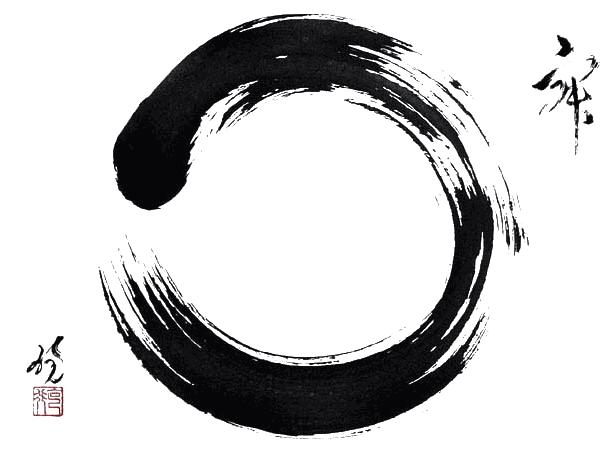
Source: modernzen.org
Sunyata, the sanskrit word for emptiness, is a concept in Buddhism which analyzes the existence and reality of everything around us. This concept claims that everything is inherently empty of identity. No single thing can exist independently from other things. This is because everything is dependent on the existence of, at the very minimum, one other thing. Thus, they ultimately conclude that everything is empty of itself since nothing cannot exist in a void on its own (New World Encyclopedia).
Emptiness in Mahayana Buddhism
Sunyata is most often a concept studied in Mahayana Buddhism as a way of being able to break out of the cycle of rebirth (Newland). Mahayana is a branch of Buddhism that aims to reach Buddhahood because they were not satisfied with ultimately only reaching the enlightenment of an Arhat at the end of their many lives. What this means is that they will follow the same path that leads to becoming an Arhat up until a certain point, and from there they have added various other forms of perfection (The Six Perfections or Paramita), which are meant to help them reach Buddhahood. One of these additional forms of perfection is that of wisdom (Prajnaparamita) and the concept of emptiness falls under this form (Bronkhorst, 121-124).

Source: Buddhanet.net
Emptiness in the Heart Sutra
The Heart Sutra is a Buddhist text written about the Perfection of Wisdom. The Bodhisattva of Compassion, Avalokiteshvara explains how the five skandhas or aggregates (form, sensations, perceptions, mental formations, and consciousness) are empty. One of the most famous lines from this text states “form is empty, emptiness is form”. This statement also extends to the rest of the skandhas. What the statement actually means is that form is empty because form is interdependent. To be interdependent means that any one thing relies on the existence of at least one other thing in order for the initial thing to exist at all. Because no thing can avoid being interdependent, then form will always be empty. Emptiness then, is form because the point of interdependence is that things can come to exist. In other words, emptiness and interdependence are the same in the sense that they explain and come to the same conclusion about how things exist and are created, and the creation and existence of things relies on being empty.
Example of Emptiness & Interdependence
A simple example given to explain the concept of emptiness is by choosing an item such as a piece of paper. The paper is empty of itself because it is interdependent. This means that the paper couldn’t exist as paper if no one had manufactured it to be a piece of paper. No one can manufacture paper if they didn’t have wood from trees, and trees are dependent on many environmental factors like sunlight and water. Continuing to expand this train of thought more and more leads to the point that a piece of paper cannot exist without the existence of all of these things, and ultimately the existence of the universe. Expanding even more, emptiness doesn’t necessarily only apply to the existence of things. As previously stated, the five aggregates are also empty, which means that something like our perception of a piece of paper are also dependent on various other things such as lighting. If the piece of paper happens to be a certain color, in a well lit room it can appear bright pink. But if the room were to be dark, the paper might appear almost red. That is to say that the piece of paper itself is not inherently a single color because it can vary due to external factors. These are not only a few examples of how form and perception are considered to be empty, but also how they are considered to be interdependent, both of which are connected to each other. (Buddhist Sympathizer)

Source: thepapermillstore.com
No Self & Emptiness
The Buddha was known to have rejected the idea of the self as he believed that there was no way to achieve enlightenment or liberation through the process of learning about oneself. This went on to become the concept of negating the self as well as negating dharma. This is significant because dharma, or the inherent nature and existence of reality, has been central to Buddhism philosophy, but Mahayana Buddhism developed to negate the existence of dharmas and realities.
The book Buddhist Teaching in India, this particular concept was written in various languages, one of which, Middle Indic, did not survive, thus certain translations of this concept makes a large difference in what is being expressed. “The sentence ‘the dharmas are not the self’ and ‘the dharmas are without self’ is highly significant” (Bronkhorst, 125). However, the development of this concept over time did not simply occur because of changes in languages. The idea of the emptiness of dharmas existed in early Mahayana texts as well. For example the Pratyutpanna-buddha-sammukhâvasthita-samadhi Sütra talks about visualization and focuses on how the experience of visualization is more dreamlike than it is real, thus leading to the conclusion that if our mind can visualize a world in this way, then our minds can also be visualizing what we consider to be actual reality, so nothing truly exists (128).
References
“Sunyata.” Sunyata – New World Encyclopedia, https://www.newworldencyclopedia.org/entry/Sunyata.
Newland, Guy. “Emptiness (Sunyata).” Emptiness (Śūnyatā) – Buddhism – Oxford Bibliographies, 19 Nov. 2019, https://www.oxfordbibliographies.com/view/document/obo-9780195393521/obo-9780195393521-0007.xml#firstMatch.
Bronkhorst, Johannes. Buddhist Teaching in India. Wisdom Publications, 2009.
Hạnh Thich Nhất. The Heart of Understanding: Commentaries on the Prajnaparamita Heart Sutra. Parallax, 2010.
“The Buddhist Concept of Emptiness (Sunyata) – What Is Emptiness?” YouTube, YouTube, 8 June 2018, https://www.youtube.com/watch?v=wErHZo06Hx4.
Further Readings
Williams, Paul. Mahāyāna Buddhism: the Doctrinal Foundations. Routledge, 2009.
This is a book that introduces Mahayana Buddhism philosophies, including straightforward explanations of the concept of emptiness. Many students and teachers have used this book as a stepping stone into the world of Mahayana Buddhism, thus it is a good source to use in order to begin exploring emptiness.
Shizuteru, Ueda, et al. “Emptiness and Fullness: Śūnyatā in Mahāyāna Buddhism.” The Eastern Buddhist, vol. 15, no. 1, 1982, pp. 9–37. JSTOR, www.jstor.org/stable/44361641.
This journal dives further into the concept of emptiness, as well as fullness, by drawing on examples of Zen Buddhism, Mahayana philosophy, and modern Japanese philosophy in order to provide clarification on these very abstract ideas. This article was published in a journal called Eastern Buddhism which provides articles on various buddhist concepts as well as translations of classical buddhist texts.
Bronkhorst, Johannes. Buddhist Teaching in India. Wisdom Publications, 2009.
This book was written in order to provide individuals outside of the world of academia a better understanding of Buddhist texts and concepts primarily by placing them within context. It does this with the idea of emptiness which helps give a clearer understanding of where it came from and how it developed into what it is now.
I really enjoyed how you decided to divide this entry. The sections were very concise and clear with a clear connection to the historical context. This post was very educational and used good textual evidence to back up your claims. Each individual section was really well written and included good analysis, but towards the end of the entry it began to feel more choppy. I think if the last two sections were switched it could have improved the design of the entry. By moving the information about the Buddha’s views regarding the self could have made the flow seem more concise as well as provide further insight while reading the examples of emptiness. I also think switching these two sections could have allowed you to dive in a little deeper into your examples of emptiness.
Overall this entry had a really nice flow and was structured very well. The descriptions of emptiness in different branches of Buddhism were easy to comprehend and the examples of emptiness helped explain the concepts of emptiness and interdependence. This was a very informative entry and I enjoyed reading it!
This entry is really really good. The manner of writing is very clear and succinct, and not only full of the information and variety of concepts that we have learned, but a really good example of emptiness and interdependence. I really like how you used the paper example to expand he two concepts. I think it is a great example because we see paper every every day as a finished product, that we would never deem as being empty. In bringing to focus the interdependence that paper has on sunlight, water, and wood, it makes the notion of emptiness and interdependence very simple to understand, and simply to apply to everyday examples.
I really enjoyed reading this entry! It is very informative, well written and structurally clearly organized. For a concept that is quite complex, especially the section on emptiness in Mahayana tradition, you were able to articulate this very clearly. I think your entry also benefited from your example of the piece of paper. Again, this analogy in the contemporary world helped clarify this seemingly abstract concept.
Perhaps you could have evaluated other perspectives and the role of no-self in other Buddhists traditions. You might have considered contradictions of no-self in Buddhism. For example, how some believe the notion of no-self seems to contradict one’s karmic motivation through re-birth and samsara. These are just a few suggestions, but overall really well done!
I thought this post was well-informed and did a great job of explaining emptiness as every object’s/being’s lack of separate identity. I particularly liked the subsection with the example of the paper, because without an example this concept becomes much harder to fully grasp. I also found the context at the start of the post very helpful for understanding the role of emptiness in general Buddhist practices, and for understanding how it came about. To that point though, I think a little more context for the notion of “no-self” could have been helpful as well, specifically in describing how or why the Buddha thought that liberation cannot come from an understanding of the self. I also think a brief description of how every object’s lack of separate identity leads to the concept of no-self (since it necessarily calls into question the idea of a personal identity). What does it mean to not have a self? I think overall this was a great post, and I enjoyed reading it.
Nice post! You have written useful and practical information. Take a look at my web blog YW9 I’m sure you’ll find supplementry information about Airport Transfer you can gain new insights from.